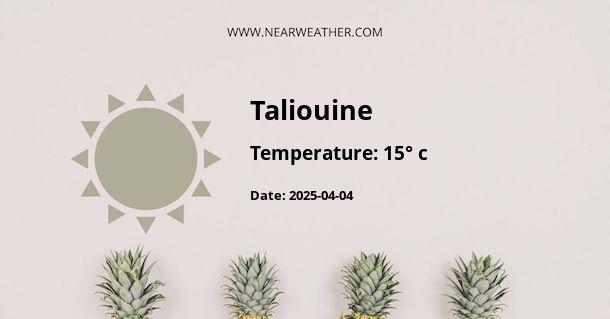Taliouine, Morocco: Climate and Weather Year Round
Taliouine is a small town located in the Souss-Massa region of Morocco. It is known for its production of saffron, which makes it a popular destination for tourists and food enthusiasts. Understanding the climate and weather patterns in Taliouine is essential for planning a trip or making informed decisions about saffron production. This article provides a comprehensive overview of Taliouine's climate and weather throughout the year.
Geographical Location
Taliouine is situated in the Atlas Mountains, approximately 1,100 meters above sea level. Its location in the southern part of Morocco experiences a Mediterranean climate, characterized by hot summers and mild winters. The town is surrounded by stunning landscapes, including mountains, valleys, and various agricultural fields.
Temperature
The temperature in Taliouine varies significantly throughout the year. Summers are hot and dry, while winters are relatively mild. Here is a breakdown of the average temperatures in Taliouine:
| Season | Average Temperature |
|---|---|
| Spring (March to May) | 15°C to 25°C |
| Summer (June to August) | 25°C to 35°C |
| Autumn (September to November) | 20°C to 30°C |
| Winter (December to February) | 10°C to 20°C |
It is important to note that temperatures can occasionally reach higher or lower extremes, so it is advisable to check the local weather forecast before planning any outdoor activities or saffron harvesting.
Precipitation
Taliouine experiences a Mediterranean climate, which means it has a distinct wet and dry season. The majority of the rainfall occurs during the winter months, while summers are generally dry. Here is an overview of the average precipitation levels in Taliouine:
| Month | Average Precipitation (mm) |
|---|---|
| January | 50 mm |
| February | 40 mm |
| March | 35 mm |
| April | 30 mm |
| May | 20 mm |
| June | 5 mm |
| July | 1 mm |
| August | 1 mm |
| September | 5 mm |
| October | 20 mm |
| November | 40 mm |
| December | 50 mm |
The dry season, which lasts from June to August, is ideal for saffron harvesting as the lack of rain reduces the risk of damage to the delicate flowers. However, the town's water supply heavily relies on the winter rainfall, making it crucial for the agricultural community.
Sunshine Hours
Taliouine enjoys a significant amount of sunshine throughout the year, with an average of around 3,000 hours annually. The highest number of sunshine hours can be experienced during the summer months, while winters also offer a fair share of sunny days. This abundant sunshine contributes to the growth and development of saffron crops, as the flowers require sunlight to produce high-quality and flavorful saffron threads.
Wind Patterns
Taliouine experiences moderate wind patterns throughout the year. The Atlas Mountains surrounding the town provide some protection from strong winds, creating a relatively calm environment. However, occasional gusts of wind can occur, especially during the transitional seasons of spring and autumn. It is advisable to consider wind conditions when planning outdoor activities or saffron harvesting, as strong winds can affect the quality and yield of the saffron flowers.
Conclusion
Taliouine, Morocco, offers a unique climate and weather experience throughout the year. Its Mediterranean climate brings hot summers, mild winters, distinct wet and dry seasons, abundant sunshine, and moderate wind patterns. These climatic conditions, combined with the town's geographical location in the Atlas Mountains, provide an ideal environment for saffron production. Whether you are planning a trip to Taliouine or interested in saffron cultivation, understanding the climate and weather patterns in this region is essential for a successful and enjoyable experience.
A - Taliouine's Latitude is 30.529169 & Longitude is -7.912620.
A - Weather in Taliouine is 26° today.
A - Climate Conditions in Taliouine shows clear sky today.
A - Humidity in Taliouine is 18% today.
A - Wind speed in Taliouine is 8.75 km/h, flowing at 141° wind direction. today.
